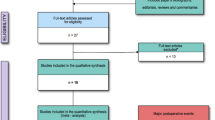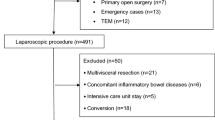Abstract
Background
Perioperative fluid management is a critical component in patients undergoing abdominal surgery. However, the benefit of restricted fluid regimen remains inconclusive. This systematic review aimed to explore potential factors causing these inconsistent findings.
Methods
The literature searches were performed in three databases including PubMed, Embase, and the Cochrane library until August 30, 2018. Only randomized, controlled trials comparing the effect of restricted versus liberal regimen in abdominal surgery were included. The primary outcome was total postoperative complications. Subgroup analysis was performed according to between-group weight increase difference (≥ 2 kg and < 2 kg) and fluid intake ratio (≥ 1.8 and < 1.8).
Results
Sixteen studies were finally included in this meta-analysis. The benefit of the restricted regimen in reducing postoperative complication was only significant in the subgroup with high weight increase difference (≥ 2 kg) (RR 0.67, 95% CI 0.57–0.79) and the subgroup with high fluid intake ratio (≥ 1.8) (RR 0.72, 95% CI 0.62–0.82). In the subgroup with low weight increase difference (< 2 kg) or low fluid intake ratio (< 1.8), the effect of the restricted regimen was not significant (RR 0.88, 95% CI 0.51–1.50, and RR 1.18, 95% CI 0.91–1.53, respectively).
Conclusions
The benefit of the restricted regimen was only significant in the subgroup with high weight increase difference (≥ 2 kg) or high fluid intake ratio (≥ 1.8).




Similar content being viewed by others
References
Weiser TG, Haynes AB, Molina G et al (2015) Estimate of the global volume of surgery in 2012: an assessment supporting improved health outcomes. Lancet 385(Suppl 2):S11
Pearse RM, Moreno RP, Bauer P et al (2012) Mortality after surgery in Europe: a 7 day cohort study. Lancet 380:1059–1065
Jhanji S, Thomas B, Ely A et al (2008) Mortality and utilisation of critical care resources amongst high-risk surgical patients in a large NHS trust. Anaesthesia 63:695–700
Ljungqvist O, Scott M, Fearon KC (2017) Enhanced recovery after surgery: a review. JAMA Surg 152:292–298
Tambyraja AL, Sengupta F, MacGregor AB et al (2004) Patterns and clinical outcomes associated with routine intravenous sodium and fluid administration after colorectal resection. World J Surg 28:1046–1051. https://doi.org/10.1007/s00268-004-7383-7 discussion 1051–1042
Arkilic CF, Taguchi A, Sharma N et al (2003) Supplemental perioperative fluid administration increases tissue oxygen pressure. Surgery 133:49–55
Shires T, Williams J, Brown F (1961) Acute change in extracellular fluids associated with major surgical procedures. Ann Surg 154:803–810
Bragg D, El-Sharkawy AM, Psaltis E et al (2015) Postoperative ileus: recent developments in pathophysiology and management. Clin Nutr 34:367–376
Barmparas G, Liou D, Lee D et al (2014) Impact of positive fluid balance on critically ill surgical patients: a prospective observational study. J Crit Care 29:936–941
Feldheiser A, Aziz O, Baldini G et al (2016) Enhanced Recovery After Surgery (ERAS) for gastrointestinal surgery, part 2: consensus statement for anaesthesia practice. Acta Anaesthesiol Scand 60:289–334
Gonzalez-Fajardo JA, Mengibar L, Brizuela JA et al (2009) Effect of postoperative restrictive fluid therapy in the recovery of patients with abdominal vascular surgery. Eur J Vasc Endovasc Surg 37:538–543
McArdle GT, McAuley DF, McKinley A et al (2009) Preliminary results of a prospective randomized trial of restrictive versus standard fluid regime in elective open abdominal aortic aneurysm repair. Ann Surg 250:28–34
Futier E, Constantin JM, Petit A et al (2010) Conservative vs restrictive individualized goal-directed fluid replacement strategy in major abdominal surgery: a prospective randomized trial. Arch Surg 145:1193–1200
Myles PS, Bellomo R, Corcoran T et al (2018) Restrictive versus liberal fluid therapy for major abdominal surgery. N Engl J Med 378:2263–2274
Lobo DN, Bostock KA, Neal KR et al (2002) Effect of salt and water balance on recovery of gastrointestinal function after elective colonic resection: a randomised controlled trial. Lancet 359:1812–1818
Brandstrup B, Tonnesen H, Beier-Holgersen R et al (2003) Effects of intravenous fluid restriction on postoperative complications: comparison of two perioperative fluid regimens: a randomized assessor-blinded multicenter trial. Ann Surg 238:641–648
Abraham-Nordling M, Hjern F, Pollack J et al (2012) Randomized clinical trial of fluid restriction in colorectal surgery. Br J Surg 99:186–191
MacKay G, Fearon K, McConnachie A et al (2006) Randomized clinical trial of the effect of postoperative intravenous fluid restriction on recovery after elective colorectal surgery. Br J Surg 93:1469–1474
Zatlo Ukal J, Pradl R, Kletecka J et al (2017) Comparison of absolute fluid restriction versus relative volume redistribution strategy in low central venous pressure anesthesia in liver resection surgery: a randomized controlled trial. Minerva Anestesiol 83:1051–1060
Srinivasa S, Taylor MH, Singh PP et al (2013) Randomized clinical trial of goal-directed fluid therapy within an enhanced recovery protocol for elective colectomy. Br J Surg 100:66–74
Vermeulen H, Hofland J, Legemate DA et al (2009) Intravenous fluid restriction after major abdominal surgery: a randomized blinded clinical trial. Trials 10:50
Nisanevich V, Felsenstein I, Almogy G et al (2005) Effect of intraoperative fluid management on outcome after intraabdominal surgery. Anesthesiology 103:25–32
Piljic D, Petricevic M, Ksela J et al (2016) Restrictive versus standard fluid regimen in elective minilaparotomy abdominal aortic repair-prospective randomized controlled trial. Thorac Cardiovasc Surg 64:296–303
Peng NH, Gao T, Chen YY et al (2013) Restricted intravenous fluid regimen reduces fluid redistribution of patients operated for abdominal malignancy. Hepatogastroenterology 60:1653–1659
Cohn SM, Pearl RG, Acosta SM et al (2010) A prospective randomized pilot study of near-infrared spectroscopy-directed restricted fluid therapy versus standard fluid therapy in patients undergoing elective colorectal surgery. Am Surg 76:1384–1392
Wuethrich PY, Burkhard FC, Thalmann GN et al (2014) Restrictive deferred hydration combined with preemptive norepinephrine infusion during radical cystectomy reduces postoperative complications and hospitalization time: a randomized clinical trial. Anesthesiology 120:365–377
Gao T, Li N, Zhang JJ et al (2012) Restricted intravenous fluid regimen reduces the rate of postoperative complications and alters immunological activity of elderly patients operated for abdominal cancer: a randomized prospective clinical trail. World J Surg 36:993–1002. https://doi.org/10.1007/s00268-012-1516-1
Grant F, Brennan MF, Allen PJ et al (2016) Prospective randomized controlled trial of liberal vs restricted perioperative fluid management in patients undergoing pancreatectomy. Ann Surg 264:591–598
Weinberg L, Ianno D, Churilov L et al (2017) Restrictive intraoperative fluid optimisation algorithm improves outcomes in patients undergoing pancreaticoduodenectomy: a prospective multicentre randomized controlled trial. PLoS ONE 12:e0183313
Higgins JP, Thompson SG (2002) Quantifying heterogeneity in a meta-analysis. Stat Med 21:1539–1558
Holte K, Foss NB, Andersen J et al (2007) Liberal or restrictive fluid administration in fast-track colonic surgery: a randomized, double-blind study. Br J Anaesth 99:500–508
Boland MR, Noorani A, Varty K et al (2013) Perioperative fluid restriction in major abdominal surgery: systematic review and meta-analysis of randomized, clinical trials. World J Surg 37:1193–1202. https://doi.org/10.1007/s00268-013-1987-8
Rahbari NN, Zimmermann JB, Schmidt T et al (2009) Meta-analysis of standard, restrictive and supplemental fluid administration in colorectal surgery. Br J Surg 96:331–341
Mayo-Wilson E, Imdad A, Herzer K et al (2011) Vitamin A supplements for preventing mortality, illness, and blindness in children aged under 5: systematic review and meta-analysis. BMJ 343:d5094
Duval S, Tweedie R (2000) Trim and fill: a simple funnel-plot-based method of testing and adjusting for publication bias in meta-analysis. Biometrics 56:455–463
Funding
This meta-analysis received funding from Zhejiang Province health high-level talents and Zhejiang Province sepsis innovation subject during the language polishing.
Author information
Authors and Affiliations
Corresponding author
Ethics declarations
Conflicts of interest
The authors declare that they have no competing interests.
Additional information
Publisher's Note
Springer Nature remains neutral with regard to jurisdictional claims in published maps and institutional affiliations.
Electronic supplementary material
Below is the link to the electronic supplementary material.
Rights and permissions
About this article
Cite this article
Shen, Y., Cai, G., Gong, S. et al. Perioperative Fluid Restriction in Abdominal Surgery: A Systematic Review and Meta-analysis. World J Surg 43, 2747–2755 (2019). https://doi.org/10.1007/s00268-019-05091-y
Published:
Issue Date:
DOI: https://doi.org/10.1007/s00268-019-05091-y




